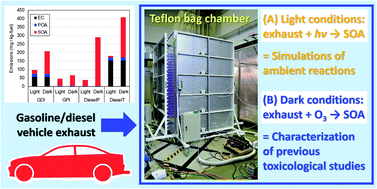Secondary organic aerosol formation from gasoline and diesel vehicle exhaust under light and dark conditions†
Abstract
Secondary organic aerosol (SOA) formed from vehicle exhaust contributes substantially to the atmospheric particulate matter in urban air but there still remain uncertainties in the simulation of the SOA by air quality models. This omission is due partly to uncertainties about the differences in SOA formation between vehicle types, exhaust aftertreatment devices, and oxidation conditions in the air. In this work, smog chamber experiments were conducted to investigate SOA formation from diluted exhaust gases emitted by two light-duty gasoline vehicles and one passenger and one medium-duty diesel vehicles. Emissions were aged in the smog chamber under light (ultraviolet) and dark (with high O3) conditions. In these experiments, there were considerable emissions of elemental carbon and primary organic aerosol by a gasoline direct-injection vehicle and a diesel truck, but the corresponding emissions were relatively small from a gasoline vehicle with port fuel injection and a passenger diesel vehicle. However, significant amounts of SOA were produced from all four vehicles. Box model simulations indicated that OH exposure was higher and the ratio of NO to peroxy radicals (HO2 + RO2) was lower under dark conditions in the presence of high added O3 than under light conditions. The higher concentrations and yields of SOA under dark conditions than under light conditions could partly be explained by the lower NO/(HO2 + RO2) ratios under dark conditions. Simulations with a volatility basis-set model indicated that aromatic compounds were the dominant precursors of SOA from gasoline vehicles (64–84%), whereas unspeciated intermediate-volatility organic compounds (IVOC) were the dominant precursors for the production of SOA from diesel vehicles (75–87%). The observed O : C ratios were higher for gasoline SOA (0.7–0.8) than diesel SOA (0.3–0.4), and this difference was explained by the differences in their precursors. SOA formed under the light and dark conditions was similar in the dominant precursors and oxidants, as well as the O : C ratios, but different in the NO/(HO2 + RO2) ratios during the oxidation processes. Thus, we cannot conclude that SOA formed under the light and dark conditions has similar chemical composition, and their characteristics should be further examined in future studies.



 Please wait while we load your content...
Please wait while we load your content...